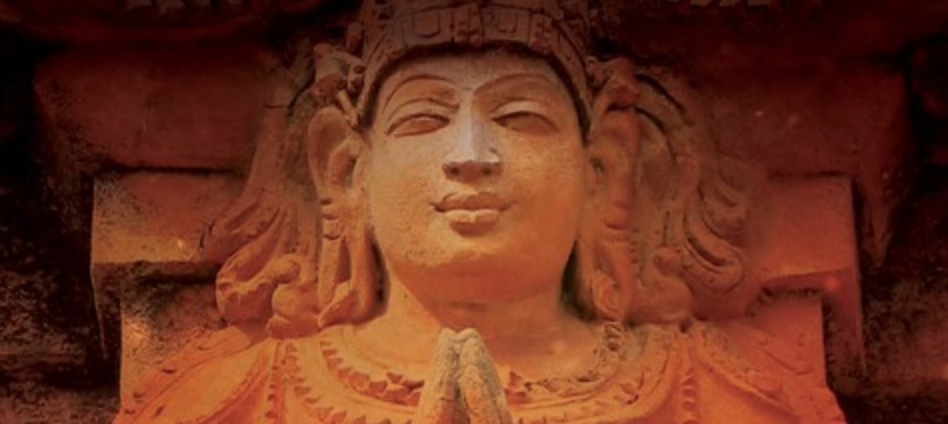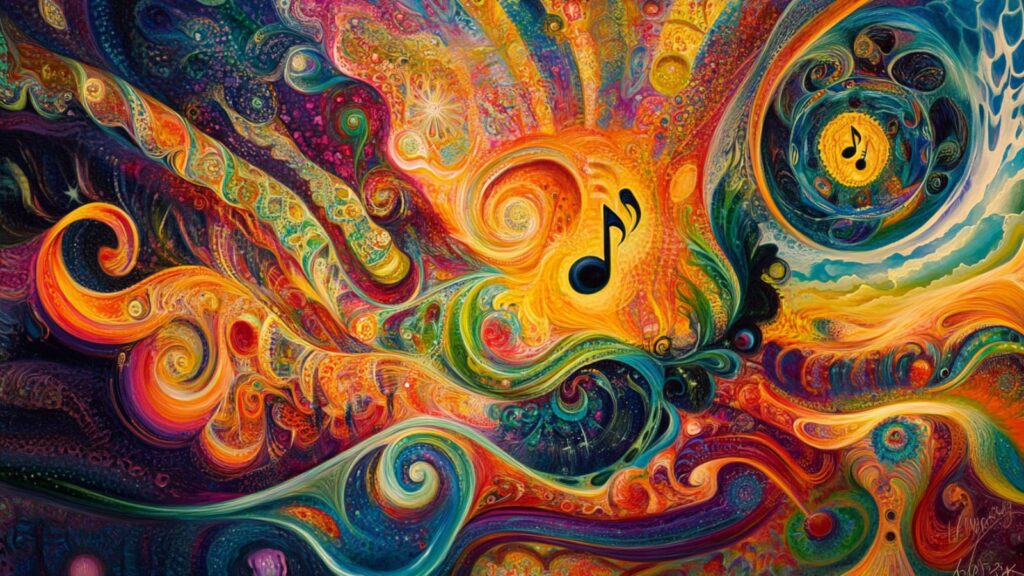The origins of yoga nidra are lost in time immemorial, and one could also say that they are lost in the mysterious source of time itself.
For some, yoga nidra originates from schools of tantric Shaivism, and for others, from Vishnuist teachings; but we also find traces in medical publications and in many other schools, whether they are tantric, Vedantic, Buddhist, in India, or elsewhere.
In India, the Lord of Sleep sometimes takes the form of Vishnu, as Narayana, consciously asleep on the waters of manifestation; and sometimes, he takes the form of the king of yogis, Shiva himself, lying down like a corpse under the dancing body of the furious Kali. In both cases, the gods represent the Ultimate Witness that we all are, the Pure Awareness that the practice of yoga nidra encourages us to recognize, or at least make ourselves available to, by opening up to it.
Both these divinities—their names as well as their representations—can be used as important tools for our practice. Devotional chanting awakens the feeling and the form, makes us humble, and inspires us, thus bringing us back to the Presence. The power of images can help us to concentrate, appease us, and connect us with ourselves. The repetition of the mantra also allows for the recognition of a silent space prior to all thoughts. All these traditional practices bring the unique taste of the divine and the joy without object; and yoga nidra only helps us to lift the veil that separates us from them. Vishnu, in the aspect of “the abode of man” (Narayana), or Shiva, in the aspect of the “benevolent corpse” (shiva-shava), like all divinities of the Indian pantheon, are nothing but inspirational forms of the One that remains, who is also the Unique Teacher, life in all its manifestations, and because of whom we can learn everything, forget everything, and understand everything.
In the Mahabharata, the great story of India, one of the chapters mentions the thousand names of Vishnu, the Omnipresent, that the famous warrior Bhishma the terrible teaches to Yudishtra, the eldest of the Pancha Pandavas. As for the myth of Narayana, some see it not only in the impersonal origins of yoga nidra, but also in the origins of the world. Everything related to these teachings carries an instruction, which therefore by analogy carries many interesting indications for the practice and the attitude to be adopted. The literal translation of this short and poetic text does not do justice to the richness of the original Sanskrit text; each word in Sanskrit deserves a short commentary, so that one can relish its profound meaning to the fullest.
I salute the Master of the Gods, whose navel sports a lotus, who lies serenely on the infinite serpent.
Foundation of the universe, like the sky, like a cloud, with harmonious limbs.
Lakshmi’s beloved Lord, the lotus-eyed, who is perceived by yogis in meditation.
I salute Vishnu, who is the destroyer of the fear of existence, the unique Lord of all worlds!
Narayana is not designated as such, but the description of this very particular aspect of Vishnu corresponds to his description. His name comes from nara (man) and ayana (refuge or abode): literally “the one in whom man finds refuge” or “the one in whom man abides.” One could also translate it as “the refuge of men” or even “he who abides in man.” He is also called Vasudeva, “God in whom all reside.” His name immediately reminds us of the Self resplendent in all of us, and outside all of us as well, because he is everywhere, at all times. Narayana lies on water in the eternal state of conscious sleep (yoga nidra). He has four arms holding a conch, a disc, a club, and a lotus. The Supreme Master remains the unmanifested observer of the dissolution of the universe into the informal state of the causal ocean. The remnants of the manifestation have coagulated to form the serpent Shesha, who serves as a bed for the god. Also known as Ananta, which signifies infinite or unlimited in Sanskrit, the cosmic serpent represents energy, the universe’s life itself, the vibration flowing in the axis of our back and in the very core of all our cells. This subtle aspect encourages us to unite (yoga) with the unchanging Witness of the phenomenal manifestations of the waking and dream states, which disappear at night in the bliss of deep sleep. Narayana is above even these three states, immersed in the bliss of the fourth state (turiya). Lying on his back, he remains happy and peaceful, in total awareness of this background of unlimited and infinite consciousness-energy, in which everything appears and disappears, where everything is born and dies, beyond even the very idea of creation or awakening, of maintaining or dreaming, of destruction or sleep. Thus tranquility seems to be a primary and essential quality.
The dissolution of the universe happens through the dissolution of the elements (tattva), from gross to subtle, like the shutting down of the senses when one falls asleep. From Narayana’s navel rises Lord Brahma, peacefully creating the worlds from his lotus seat. The representation of Narayana, paradoxical symbol of the unmanifested, has very powerful symbolism: lying down, asleep on the shoreless waters in the corpse pose (shavasana), he is contemplating, in eternal yoga nidra, the worlds appearing and disappearing within him, that do not affect him, thereby explaining his peaceful appearance that the yogi is encouraged to imitate and share. He witnesses the actions of the three gods of the Trimurti: Brahma, who Generates; Vishnu, who Organizes; and Shiva, who Destroys (together these three roles form G.O.D.). Thus he is beyond them all, Parabrahman, the Unmanifested, the Supreme above the supreme, and the Absolute Space that contains everything. The serpent is the bed (or the yoga mat) on which he sleeps. The serpent is not any ordinary one, and because it is carrying the Omnipresent himself, it is also That itself, like the Shiva-Shakti couple, signifying Consciousness and Energy.
Here the serpent incarnates force, power, kundalini-shakti, the energy at the very source of all manifestation springing from Narayana’s navel, by the grace of Brahma who is generating and creating the worlds and is seated on the pink lotus that symbolizes beauty and purity. As an epithet it refers to the goddess Lakshmi (“pure as a lotus”), Narayana’s Shakti, touching the feet of her beloved—who rules over all gods—in order to make him feel her presence, just as the yogi brings his attention to his foot to become aware of it.
Narayana is the pillar, the base, the support, the foundation, and the container of the entire universe and of all the worlds; he contains everything, he is omnipresent. He is not only what is happening, but the very space that allows things to happen and all phenomena to appear. He is the very space of Awareness; he is like the sky; he resembles it, is infinite and unlimited. Outwardly, in appearance, his skin is the color of the clouds. He is the essence of sounds and words, of prose and poetry; he is the flavor of everything. The limbs of his body are bright, luminous, golden, beautiful, splendid, and auspicious. He crystallizes positive qualities, reminding us that he is also happy, distinguished, honest, virtuous, and prosperous; this last quality is reinforced by the symbolism of the goddess. He is indeed the husband, the magnificent beloved of the splendid Lakshmi, whose name means “fortune,” the goddess of prosperity and luck, riches and abundance. She is born from a lotus created by the churning of the primordial ocean of milk. She is often represented on a lotus-shaped pedestal, holding a lotus symbolizing abundance, often shown with two elephants. Businessmen in India invoke her as they cash in money from a transaction, or to ensure material prosperity. Narayana has eyes like a pink lotus, evoking the ten forces of Shakti and the eyes of Lord Krishna, the lotus-eyed. The yogis who practice meditation (dhyana) unite with Narayana (that is, they recognize him in themselves), in whom their fears dissolve. By practicing yoga nidra, by socializing with Narayana, imitating him, meeting him, and understanding him, the duality of desires and aversions will be surpassed. In Narayana, in conscious deep sleep, one finds rest and peace of the soul (atman).
The last verse encourages total abandonment and surrender to the background of attention. I welcome, I salute, I pay tribute, I show respect, I praise, revere, celebrate, and honor Lord Vishnu, to whom I offer myself entirely: not to an outer representation, not to a mere idol, but to the all-embracing consciousness itself, without form (as indicated by the root of the word vish, to spread, expand, penetrate, bathe in), that dazzles the world by the play of its projections, thus creating illusion (maya). The experience of recognizing the Self eliminates the fear, dread, and distress related to one’s existence. Bhava, “Being,” and Hara, “the Remover,” are epithets of Shiva that dissolve the torments of birth, dream, and wakefulness in deep sleep, similar to death, which in Narayana is a mere concept projected by the mind.
The merging with the One destroys all false vision, erasing identification with the multiple manifestations of the non-Self. Hari-Hara (who removes) also articulates the union of Vishnu and Shiva, as related in the Skanda Upanishad: “Vishnu is Shiva’s heart, and Shiva is Vishnu’s.” The Lord of the Unmanifest is the grand master who takes all forms: he is unique, he is One without a second, the only One, the master of the entire universe, of all the worlds and phenomena that appear, are held, and disappear in him.
Similarly, we could also apply the same qualities to Shiva, the benevolent and the Lord of Sleep. In one of his numerous representations, he is shown lying down under the goddess Kali, who is dancing on his lifeless body, after a tough battle:
Intoxicated with the blood of the demons, Kali began to dance about wildly on the battlefield. The universe, rattled at its very foundation, swayed under her feet. All of creation could be destroyed by the goddess’s frenzy. So Shiva, in order to save the world, threw himself under Kali’s feet and absorbed the terrible vibrations into his own body. The goddess, having realized how much she was endangering the world, stuck out her tongue in shame, and thus regained her peaceful aspect of Parvati.3
Without energy (shakti), God himself would be nothing but a lifeless body, a corpse (shava); but this energy would not exist had it not been for this unique source of all life. The couple symbolizes the unity of all things, the surpassing of all opposites and duality of phenomena, as well as the recognition of the unchanging in the very heart of the moving ephemeral. In the practice of yoga nidra, Shiva is the motionless witness of the vibrating awareness in the body’s cells, the tranquil spectator of sensations, thoughts, or images, and of all phenomena that continuously appear and disappear within him, at all times. In this legend, Shiva also appears as a child in order to awaken Ma Kali’s, or the Mother’s, compassion. This myth refers directly to our practice; with the attitude of a child who is discovering the world for the first time, without bias or prejudice, the energy calms down, takes charge, comforts, and nourishes. Be it in the corpse form or in the form of a child, Shiva awakens compassion and love. Ultimately, the goddess of consciousness is only cutting the ropes of illusion and the heads of ego that separate us from the pure joy that we seek in external pleasures even though it is already within us, in the mystery of the being.
This is why the mantra (or prayer) always encourages us to bow down to and salute, celebrate, remember, and unite with this Pure Awareness present in all of us, beyond the multiple forms taken by the gods and goddesses of India and elsewhere. Spiritual salutation, if I may use the term, encourages a transformation of vision, a coming back of the attention to itself, a presence to the openness and dissolution of thoughts in the Self. The rhythm of the mantra—be it Om namah shivaya or Om namo narayanaya—also expresses this dissolution and progressive sinking into the depths of oneself and of conscious sleep. The mantra calls for the energy flooding the background to unite with this “I am” knowledge, ever peaceful witness to that which appears and disappears. The very vibration of AUM encourages one to feel the manifestations of wakefulness (A), dream state (U), and deep sleep (M), which all eventually dissolve in the underlying and silent essence of the sensitive aspect of sound. Narayana, like Shiva, is in everything and contains everything; he is vast and he is expansion itself. He is the Self, the Consciousness (chit), the Supreme Being (sat) overflowing with bliss (ananda), which alternately takes the forms of creation, organization, and destruction. He is the great I, all-pervasive, beyond time and space, and beyond space and its contents; he is the grand master who teaches the seers the art of sleeping of the sages.
As for the term nidra, it has many meanings. Sometimes, it designates the act of sleeping or falling asleep; sometimes it refers to sleep with or without dreams, or it may refer to losing consciousness in the literal sense as well as to the disappearing of the mind or all attention.* But is also designates total awareness in deep sleep, in dream state, or in wakefulness; thus, it is no more than the very nature of Shiva or Vishnu. It is That. The term yoga nidra therefore directly refers to the union with this Presence; or rather, it refers to recognizing this Presence. For it is not bound by a common subject-object relationship, but rather refers to an intuitive holding, with no subject to hold. Hence, yoga nidra is both the means and the end leading to this. Adi Shankaracharya, the great master of nonduality (Advaita Vedanta), writes in one of his essays:
Through appropriate practice, done steadily when all thoughts and intentions are completely rooted out, when we are freed totally from the web of Karma, then the yogi reaches and remains in the state of Yoga Nidra.
Resting in the bed of the Turiya state, higher than the other three states; always having the vision of the highest; my dear friend, enter and remain in the Nirvikalpa state, the state of Yoga Nidra.
Here, Shankaracharya reminds us of the aim of yoga: with the stopping of discursive and associative thoughts, certainty and doubt are immediately rooted out. With sincere practice, this quality of total awareness, which he presently refers to as “Yoga Nidra,” grows in the yogi. Opening up to the unknown allows one to encounter peace in this mysterious fourth space in which the states of waking, dreaming, and deep sleep appear and disappear. The aim of yoga nidra as a means is to recognize and understand all the manifestations of these states in a deep, alert, and equanimous state of peace. For in order to let go of something, one must know what one is holding on to. Thus, by observing and letting go of all phenomena, the yogi can finally enjoy this never-ending sleep, empty of all thoughts, whether he is busy doing something, dreaming, or fast asleep.
***













